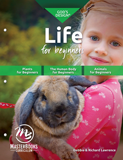Animal Tool Use
Some animals use “tools” to perform tasks, but these phenomena are far simpler than the tool-making abilities God gave to people.
A recent news article detailed how members of a species of wild cockatoos use pieces of wood as tools to break into a fruit to access its seeds.1 These reports of animals making and using tools appear from time to time in the popular media, usually accompanied by unwarranted speculation on how it evolved. Tool use, however, does not fit well within the evolutionary view.
Animal tool use is a popular topic at lay levels of science. People can watch an animal use a tool and immediately, innately understand exactly what the animal is trying to do. This can lead to projection, where humans begin to see tool use in animals where it does not exist. It is, therefore, important to define what is meant by the phrase tool use.
What’s in a Name?
Tool use is surprisingly hard to define. For example, is a branch used as a fly-swatter a tool but a vine is not because the branch is disconnected from the tree?2 What, even, is a tool? According to the dictionary, a tool is “a handheld device that aids in accomplishing a task.”3 However, many of the animals using “tools” do not have hands, nor are they using devices, so this definition will not quite do. Unfortunately, the scientific definitions of tool use lack a firm consensus. There are nearly as many definitions as there are papers on the subject.
Some have argued that tool use implies “altering the physical properties of another object, substance, surface, or medium (the target, which may be the tool user or another organism)” by use of a “freely manipulable external object.”4 The authors add then that the tool might be used to mediate “the flow of information between the tool user and the environment or other organisms in the environment.” Effectively the definition means that if an object is used to alter the environment or provide information about the environment to the organism, it is a tool, and therefore the organism is performing tool use. Many define tool use, therefore, as the use of an external item to manipulate or learn about the environment.
Many define tool use, therefore, as the use of an external item to manipulate or learn about the environment.
Tool use in animals is fairly widespread. One helpful paper revealed 247 genera had at least one instance of tool use attributed to them.5 Represented on the list are birds, mammals, fish, cephalopods, gastropods, crustaceans, and insects. The wide array of organisms that make up this list and the sheer number cannot be viewed as coincidental or dismissed out of hand.
Birds
As noted above, birds have been observed using tools. In fact, bird tool usage is among the most common on the list. In a well-known experiment, rooks used rocks to raise the water level in a container so that they could reach a reward. Some even learned to use larger rocks to raise the water level faster.6 Similar research with Eurasian jays demonstrated they learned in a similar fashion.7 While the rooks and jays were captive birds trained to use tools, other birds can learn this naturally. The aforementioned cockatoos were able to access the seeds of a fruit naturally found in their habitat by not just using but also crafting wooden tools to penetrate the husk of the fruit.8 The fact that these birds did not just use tools but actually manufactured them unprompted is impressive and is the first known example of non-primates manufacturing tools.
Cephalopods
It is well known that cephalopods, particularly octopuses, are very intelligent. So it should be no surprise that, despite being underwater creatures and thus subject to less observation, they have been found to use tools. Octopus like to live in abandoned shells, including coconut shells. They have been observed living in coconut shells, moving the shells with them when they travel, and correctly reassembling the shells when they decide to stop.9 Because the octopuses are capable of repeatedly correctly reassembling the shell pieces, this use would qualify as using the coconut shells as tools.
Fish
The black spot tuskfish is documented to use rocks to crack open the shells of its prey.
Most people would not think of fish using tools because fish lack appendages like other vertebrates. However, some species do use tools in at least a rudimentary sense. For example, the black spot tuskfish is documented to use rocks to crack open the shells of its prey.10 At least one other species of tuskfish performs identical behavior.11 Whitetail majors will clean their chosen nesting site by spraying it with sand, effectively sandblasting it.12
Gastropods
In a very interesting study, two species of marine snail from the genus Tegula were discovered to use rocks to right themselves. A snail with its soft foot exposed to the world is easy prey to any passing predator. Thus when flipped by the surf or any other mechanism, it is crucial that they be able to right themselves. The Tegula snails do this by grasping stones from the substrate with a special organ and passing them along their foot to serve as counterweights to their shell and eventually flip themselves back upright.13
Insects
Surprisingly numerous species of insects make active use of tools for various reasons. One species of assassin bug that feeds on termites will use the carcass of its first victim as bait to attract a second.14 The larva of a sawfly species save the resin of the plant they feed on in pouches in their foregut and discharge it onto potential predators.15 Numerous species of ants will use grains of sand to transport liquids to their nests.16 All of these fit the definition of tool use in one way or another.
Mammals
As would be more expected, perhaps, mammals are noted for tool use. For example, dolphins will use sponges when foraging over an abrasive substrate to cushion their beaks.17 Bears will use rocks to clean their fur or scratch an itch, much like they are famous for rubbing against trees.18 Sea otters are famous for using rocks to crack open their prey.19 All these would be considered tool use.
Given the evolutionary mindset that pervades the scientific community, it is hardly surprising that most of the tool-use research has featured man’s “closest living relatives.”
Primates, however, are the textbook example of tool use. Given the evolutionary mindset that pervades the scientific community, it is hardly surprising that most of the tool-use research has featured man’s “closest living relatives.” Chimps are known to hunt their prey with tools20 or use the same types of tools for other purposes.21 Capuchins are known to use stones to crack nuts22, and macaques have been trained not just to use tools but to pick the right tool for each task.23
Implications
Many species are documented using tools, in some cases in multiple ways and across multiple studies. Evolutionists often try to spin this to suggest that humans are not special and to support the idea that chimps make tools because they are our nearest living relative. With the discovery that at least one species of cockatoo makes tools,24 cold water has been thrown on that argument: apparently tool manufacture is not unique to the so-called “human lineage.”
Tool use is difficult for evolutionists to explain, starting from their shared ancestry model. Even organisms that are closely related phylogenetically differ in their ability to use and make tools. Thus tool use, or at least the ability to learn to use tools, must have evolved multiple times across multiple taxonomic groups, separated by hundreds of millions of years of evolutionary time. Further, given the fitness advantage of using tools, tool use and manufacture should be favored by selection and preserved in descendants. Yet it seems to appear randomly, with no close phylogenetic links between tool-using organisms. For example, while tuskfish have been recorded using tools, many of their close relatives according to phylogenetics have not. A separate ancestry model of created kinds, each fitted with the cognitive abilities needed to fulfill their designed roles, works much better to explain the widespread, unrelated organisms that use tools.
Further, arguing that humans are not special because animals make tools too is specious.
Further, arguing that humans are not special because animals make tools too is specious. What makes humans special is not our ability to make tools, do math, or solve puzzles. While it is clear that man possesses many abilities that animals haven’t come close to attaining, what makes man special is that he is made in the very image of God (Genesis 1:26–27). While theologians have long debated the exact meaning of this, one thing the image of God entails is the ability to have a direct, personal relationship with the Creator of the universe, something no animal, chimp, or otherwise, can ever attain.
Footnotes
- Christa Leste-Lasserre “Wild Cockatoos Make Utensils out of Tree Branches to Open Fruit Pits,” New Scientist August 31, 2021, https://newscientist.com/article/2288714-wild-cockatoos-make-utensils-out-of-tree-branches-to-open-fruit-pits/.
- Richard Byrne and Amanda Seed “Animal Tool Use,” Current Biology 20, no. 23 (2010), R1032-R1039, https://www.sciencedirect.com/science/article/pii/S0960982210011607#bib6.
- Merriam-Webster “Tool,” Accessed September 9, 2021, https://www.merriam-webster.com/dictionary/tool.
- Robert St. Amant and Thomas E. Horton “Revisiting the Definition of Animal Tool Use,” Animal Behaviour 75, no. 4 (2008), 1199-1208, https://repository.lib.ncsu.edu/bitstream/handle/1840.4/1112/TR-2007-16.pdf?sequence=1.
- Vicki K. Bentley-Condit and E.O. Smith. “Animal Tool Use: Current Definitions and an Updated Comprehensive Catalog,” Behaviour 147, no. 2 (2010) 185-221, https://eosmith.com/wp-content/uploads/2013/08/Bentley-Condit-Smith-Animal-Tool-Use.pdf.
- Christopher David Bird and Nathan John Emery “Rooks Use Stones to Raise the Water Level to Reach a Floating Worm.” Current Biology 19, no. 16 (2009), 1410-1414, https://www.sciencedirect.com/science/article/pii/S0960982209014559.
- Nicola S. Clayton, Lucy G. Cheke and Christopher D. Bird “Tool-Use and Instrumental Learning in Eurasian Jay (Garrulus glandarius),” Animal Cognition 14 (2011), 441-455, https://link.springer.com/article/10.1007%2Fs10071-011-0379-4.
- Mark O’Hara et al., “Wild Goffin’s Cockatoos Flexibly Manufacture and Use Tool Sets,” Current Biology (2021) https://www.cell.com/current-biology/fulltext/S0960-9822(21)01111-8.
- Julian K. Finn, Tom Tregenza, and Mark D. Norman “Defensive Tool Use in a Coconut-carrying Octopus,” Current Biology 19, no. 23 (2009) R1069-1070, https://www.sciencedirect.com/science/article/pii/S0960982209019149.
- A.M. Jones, C. Brown, and S. Gardner “Tool Use in the Tuskfish Choerodon schoenleinii?” Coral Reefs 30 (2011), 865, https://www.researchgate.net/profile/Culum-Brown/publication/225930642_Tool_use_in_the_tuskfish_Choerodon_schoenleinii/links/02bfe5138255a5817e000000/Tool-use-in-the-tuskfish-Choerodon-schoenleinii.pdf.
- Kimberley J. Pryor and Ashley M. Milton “Tool Use by the Graphic Tuskfish Choerodon graphicus,” Journal of Fish Biology 95, no. 2 (2019), 663-667, https://onlinelibrary.wiley.com/doi/full/10.1111/jfb.13983.
- Culum Brown “Tool Use in Fishes,” Fish and Fisheries 13 (2012), 105-115, https://www.wellbeingintlstudiesrepository.org/cgi/viewcontent.cgi?article=1077&context=acwp_asie.
- Paul J. Weldon and Daniel J. Hoffman “Unique Form of Tool-using in Two Gastropod Molluscs (Trochidae),” Nature 256, (1975), 720-721, https://www.nature.com/articles/256720a0.
- E.A. McMahan “Bait-and-Capture Strategy of a Termite-Eating Assassin Bug,” Insectes Sociaux 29, (1982), 346-351, https://link.springer.com/article/10.1007%2FBF02228761.
- Thomas Eisner et al., “Defensive Use by an Insect of Plant Resin,” Science 184, no. 4140 (1974), 996-999, https://www.jstor.org/stable/1738344.
- John D. Pierce Jr. “A Review of Tool Use in Insects,” The Florida Entomologist 69, no. 1 (1986), 95-104, https://www.jstor.org/stable/3494748.
- Michael Krutzen et al., “Cultural Transmission of Tool Use in Bottlenose Dolphins,” Proceedings of the National Academy of Science USA. 102, no. 25 (2005), 8939-8943, https://www.pnas.org/content/102/25/8939.full.
- Volker B. Deecke “Tool Use in the Brown Bear (Ursus arctos),” Animal Cognition 15 (2012), 725-730, https://insight.cumbria.ac.uk/id/eprint/1687/1/Deecke_ToolUseInTheBrownBear.pdf.
- Jessica A. Fujii, Katherine Ralls and M. Tim Tinker. “Food Abundance, Prey Morphology, and Diet Specialization Influence Individual Sea Otter Tool Use,” Behavioral Ecology 28, no. 5 (2017), 1206-1216, https://academic.oup.com/beheco/article/28/5/1206/4001444?login=true.
- Michael A. Huffman and Mohamedi Seifu Kallunde “Tool-Assisted Predation on a Squirrel by a Female Chimpanzee in the Mahale Mountains, Tanzania,” Primates 34, no. 1 (1993), 93-98, https://www.researchgate.net/profile/Michael_Huffman/publication/226899514_Tool-assisted_Predation_on_a_Squirrel_by_a_Female_Chimpanzee_in_the_Mahale_Mountains_Tanzania/links/581c389f08aeccc08aeb7cb0/Tool-assisted-Predation-on-a-Squirrel-by-a-Female-Chimpanzee-in-the-Mahale-Mountains-Tanzania.pdf.
- Ebang Ella Ghislain Wilfried and Juichi Yamagiwa “Use of Tool Sets by Chimpanzees for Multiple Purposes in Moukalaba-Doudou National Park, Gabon,” Primates 55 (2014), 467-472, https://www.researchgate.net/profile/Ghislain-Ella/publication/263016202_Use_of_tool_sets_by_chimpanzees_for_multiple_purposes_in_Moukalaba-Doudou_National_Park_Gabon/links/5d4960ff92851cd046a5a517/Use-of-tool-sets-by-chimpanzees-for-multiple-purposes-in-Moukalaba-Doudou-National-Park-Gabon.pdf.
- Eduardo B. Ottoni and Patricia Izar “Capuchin Monkey Tool Use: Overview and Implications,” Evolutionary Anthropology 17, no. 4 (2008), 171-178, https://citeseerx.ist.psu.edu/viewdoc/download?doi=10.1.1.506.2143&rep=rep1&type=pdf.
- Sayaka Hihara et al., “Rapid Learning of Sequential Tool Use by Macaque Monkeys,” Physiology & Behavior 78, no. 3 (2003), 427-434, https://www.sciencedirect.com/science/article/abs/pii/S0031938402010065.
- O’Hara et al., "Cockatoos," 2021.
Recommended Resources

Answers in Genesis is an apologetics ministry, dedicated to helping Christians defend their faith and proclaim the good news of Jesus Christ.
- Customer Service 800.778.3390
- Available Monday–Friday | 9 AM–5 PM ET
- © 2025 Answers in Genesis






